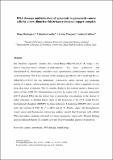DNA damage and induction of apoptosis in pancreatic cancer cells by a new dinuclear bis(triazacyclonane) copper complex

View/
Date
2015-01-26Author
Montagner, Diego
Gandin, Valentina
Marzano, Cristina
Erxleben, Andrea
Metadata
Show full item recordUsage
This item's downloads: 432 (view details)
Cited 30 times in Scopus (view citations)
Recommended Citation
Montagner, Diego, Gandin, Valentina, Marzano, Cristina, & Erxleben, Andrea. (2015). DNA damage and induction of apoptosis in pancreatic cancer cells by a new dinuclear bis(triazacyclonane) copper complex. Journal of Inorganic Biochemistry, 145, 101-107. doi: https://doi.org/10.1016/j.jinorgbio.2015.01.013
Published Version
Abstract
The dinuclear copper(II) complex [Cu-2{bcmp(-H)}(mu-OH)](NO3)(2)center dot H2O (1, bcmp = 2,6-bis(1,4,7-triazacyclonon-1-ylmethyl)-4-methylphenol) has been synthesized and characterized by electrospray ionization mass spectrometry, potentiometric titration and cyclovoltammetry. The X-ray structure of the analogous perchlorate salt [Cu-2{bcmp(-H)}(mu-OH)](ClO4)(2)center dot 2.5H(2)O (2) was determined. Cytotoxicity studies showed very promising activity of 1 against various pancreatic tumor cell lines with IC50 values comparable or even lower than those of cisplatin. The Cu complex displayed low toxicity against a human non-tumor cell line (HEM 293) demonstrating selectivity for cancer cells. 1 converts supercoiled pUC19 plasmid DNA into the nicked form at micromolar concentrations in the absence of added reductants. A detailed kinetic study on the hydrolysis of the DNA model bis(2,4-dinitrophenyl) phosphate (BDNPP) has been performed. 1 hydrolyses BDNPP with a second order rate constant of 0.047 M s(-1) at pH 8 and 40 degrees C. Finally, single cell electrophoresis (comet assay) and fluorescence microscopy analysis showed that 1 interacts with cellular DNA and induces apoptotic cell death of Capan-1 pancreatic cancer cells. Western blotting analysis indicated that the Cu complex activates the p53 dependent pathway of apoptosis. (C) 2015 Elsevier Inc. All rights reserved.

